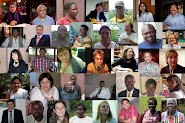

by Kristin Naituli and Bancy Wanjiru
It was indeed a great learning opportunity for the three of us, [Kristin Naituli, Mary Chepkoech and Bancy Wanjiru] in hosting a recent Leadership Essentials workshop. We had a huge number of participants, so much content to deliver over a very short period of time and with limited resources. But guess what! WE DID IT! We did our best, though everything didn’t go the way we expected or planned, but those were learning opportunities for us. Having not had an experience like that before, the students were eager to learn, very excited about the whole idea and very happy to be involved. In fact, most of them want to be involved in such a program more often. They want to develop leadership competencies at a personal and corporate level.
This most recent run of Leadership Essentials was a one day event that took place on Saturday Nov 22, 2008 at Egerton University, Njoro Campus. We had 74 subjects from the Student Leadership Practices Inventory survey, then 8 student assistants, and 5 participants from ERMIS Africa.
We invited the Deputy Vice Chancellor for Administration & Finance, a Professor who is also on the Board of ERMIS Africa, and a lecturer involved in student career-development. These three started out by sharing about their leadership development journey and the students really loved having real leaders talk about their real life experiences. The leaders also expressed gratitude and appreciation for being invited to this very special and groundbreaking event.
We facilitated the Visual Explorer tool to define leadership and to clarify the distinction between management and leadership. After tea-break we spent considerable time explaining the Kouzes and Posner Leadership model including The Five Practices of exemplary leadership (practices they were being evaluated on in their 360-assessment instrument):
- Model the way
- Inspire a shared vision
- Challenge the process
- Enable others to act, and
- Encourage the heart
We then distributed the personal leadership profiles (from the 360-degree assessment using Student Leadership Practices Inventory (SLPI) to each of the students and went through each page of the report / profile explaining it step by step ending with a brief session on personal action-planning to improve on leadership practices based on the strengths and development needs on the feedback report. After lunch we came back for Development is Dynamic and Learning Curve, Emotional Intelligence, and Situation Behavior Impact Feedback Model (SBI).
As we delivered the training and interacted with the students, we realized what we were offering was actually what they were looking for. They are thirsty for more, they want to be prepared mentally for the challenges awaiting them in the market place and so we felt the need to prepare a proactive toolkit – at least for 4th year college students who are about to get to the job market, take them through a basic course with important elements like Mental Models, Development is Dynamic, the Learning Curve, Essentials of Emotional Intelligence, SBI feedback as well as personality preference tests to help them know themselves and understand others. These are tools that would be very useful to young professionals who are going out into a competitive market place with aspirations of taking leadership in various fields.
We also had assessment forms in place similar to the forms given to us by CCL to use for the workshops we facilitated the last week in Addis. As we handed out the forms at the end of the day and the students started filling them, our microphone team put this really soothing music on through the speakers. And we witnessed the entire room settling down at an instant, actually the group as a whole was transcending in front of our eyes and all of a sudden this tranquil peace dawned and stayed with us as they were all really focused on filling their feedback forms, down to the last line item. It was almost divine! We could basically touch and feel the peace and the joyous energy just take hold of all of us.
In this elated atmosphere we did our closing ceremony calling each of the participants by name and having them come up to shake hands and receive a certificate of participation. We resolved to engage in the five practices more often and as such enhance our individual leadership capacities. We ended as we had started with a word of prayer and a vote of thanks.
In addition to the workshop modules, we had a "democracy-wall" at the back of the room with paper, markers, tape and space for participants to express their feelings, discoveries, observations and suggestions (I FELT, I NOTICED, I DISCOVERED, I WOULD LIKE TO SUGGEST) as the workshop was progressed. It’s always a joy to see this noble task of developing leaders grow from one level to another with every passing year.
 Through interactive activities, discussion, practice and reflection, participants work through the following questions with their peers and CCL staff throughout the week.
Through interactive activities, discussion, practice and reflection, participants work through the following questions with their peers and CCL staff throughout the week. 










































